There has not been the expected increase in businesses at D’Edward Village, West Coast Berbice, following the opening of the Berbice River Bridge, but residents said the cost for houses at the location had certainly risen.
Residents told this newspaper during a visit there that after most of the snackettes at the Rosignol Ferry Stelling were forced to close they felt there would have been an increase in business in the vicinity of the bridge. After all, they pointed out, the area had become popular and many persons wanted to purchase houses there.
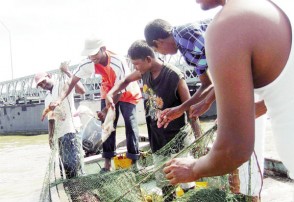
With the festive season on, stores were stocked with fancy decorations, silk flowers, toys and curtains, as well as walnuts, apples and grapes. Business owners told this newspaper that the items attracted a lot of “window shoppers” but there was hardly any real shopping going on. They noted that in the previous years leading up to the holidays, sales were much better although they hoped that these would still pick up. The reason for the sluggishness, they said, was because the bridge had resulted in the establishment of a lot of new businesses in nearby Rosignol, and they “have more shops than shoppers now.”

But one resident told this newspaper that “we willing to buy but we don’t have the money.” She said too that “prices for food items gone up in the shops, so by the time we finish buying that we don’t have money for extra shopping.”
D’Edward has a population of about 300 and is dominated by Indian-Guyanese. The village was “very bright” when the Atma Cinema was in operation several years ago, and attracted persons from “all around.” But along with others around the country, it was forced to close several years ago on account of the piracy of movies, among other things.
Residents said that the area had become “dismal”; you never used to hear about D’Edward much. But now the village has regained its popularity “because of the bridge.”
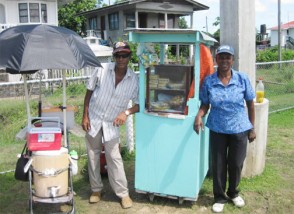
They described the village as being “quiet,” noting that villagers were not “rowdy” and shared a good relationship.
Bus park
Residents were not happy with the new arrangement to have the Route 56 bus park at the Rosignol Stelling. They said they used to be able to go out of their homes and catch a bus to take them to New Amsterdam for $300. Now they have to pay an extra $100 to go to the stelling to join a bus and lamented that this was “unfair.”
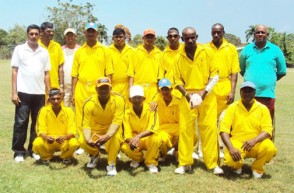
Further, on their return, instead of dropping them off at D’ Edward, the bus would take them to Rosignol again “because the police would charge them if they stop. We end up paying $800 for a return trip just to cross the bridge.”
They said because of the exorbitant fares they would “only go to New Amsterdam (NA) when it absolutely necessary.” Besides, they said, “When we go we try to do all we business in one day.”
They nevertheless “prefer the bridge to the ferry any day.” Even though they sometimes had to wait a long time to cross with the ferry, they visited NA more often, noting that “the buses take a long time to full; people ain’t crossing…” They paid a fare of $120 for a return trip with the ferry and would visit popular shopping centres and eating places.
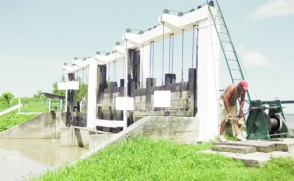
Since the bridge, they do their shopping in West Berbice, particularly at Rosignol where an increase in business activities has been observed. Rosignol also has two banks “so we don’t really need to go across the bridge much.”
They also observed that there was no public convenience at the park and some men would “urinate all over and make the place stink.”
Vendors
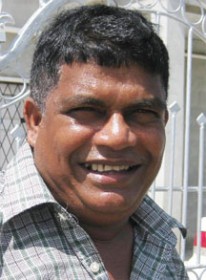
When this newspaper visited the village last week, the bridge was just opening to traffic after a scheduled closure.
A few vendors were walking around selling chips, snow cones and water coconuts to vehicle occupants, while a couple, Fazil Khan and his reputed wife, Seeta Singh had set up a small mobile snackette. Singh said they made pastry, dhal puri, phularie and various items to sell daily, as well as cane juice and other beverages. However, no permanent vending is allowed in the vicinity of the bridge.
Khan said he was employed at the Transport & Harbours Department but because of the bridge, he along with other workers had been sent home “just like that.”
He said they had invested in a poultry business but that flopped because large-scale businesspersons from Canje and Albion would come across the bridge and sell chicken at a cheaper price. They could not compete with that market and with the high price for feed they were forced to close the venture.
Omesh Saffie who has been selling plantain and sweet potato chips and ‘salt sei’ for the past five years was at the bridge with his basket of chips.
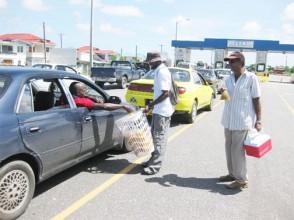
He went around to the vehicles and some of the drivers and passengers purchased from him. But he does not wait at the bridge everyday hoping for a “sale” because “nobody don’t stop and buy.”
He started off selling at the Rosignol Stelling where he was “getting good sales,” but activities had slowed down there because of the bridge. Now, he said “it is very hard. I have to ride and sell all over the place and I don’t make much money.”
This newspaper also caught up with vendor, Richard Hargobin, who sells coconuts three days per week. The other days he tends to his kitchen garden. He purchases the coconuts from farmers and “sometimes I clear and sometimes I would lose, but I have to do something to make a living.”
He too gets an increase in sales when the bridge is closed and the traffic builds up.
He and his brother, James also assist their mother, ‘Chukun’ Hargobin, a newspaper vendor for several years, to sell her newspapers. Chukun used to sell papers at the Rosignol Stelling but was forced to move close to the bridge. But even there sales are a bit slow.
Fish business
At another spot close to the bridge, a group of men were sitting under a makeshift tent with baskets and buckets. They were selling hassar.
They leave home at 4 am to go to the Abary Creek to fish. They would wait until they “get an amount to make a day’s pay before we come out.” That means that they sometimes camp out in the area for about two days.
One of the men, Rajin Munshie said that “sometimes the market is rough.” But other times sales would be good.
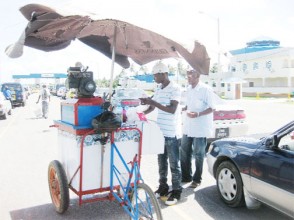
Azad Karim who sets up the tent every day said the prices started from $1,000 per parcel, depending on the size. The business is their main source of income.
Over at the three-door koker close to the Berbice Bridge, a few fishermen with their boats moored, had set their seines and were waiting to pull them in. Two workers at the sluice were opening the doors to allow the water to flow in because of the low tide.
The fishermen took this reporter on a short trip in a boat as they pulled in a set of seines. They caught some small-sized fish which they stocked in an ice-bucket.
Shazim Haniff who owns a small boat said sometimes he and his workers would set off for the deep sea to catch the “big fish” and return around 5 pm. Other times they would have to spend three days before they get enough. The larger boats would spend five days.
But the business is not lucrative any more so he and the others prefer to set their seines close to the shore and make do with the little that they catch.
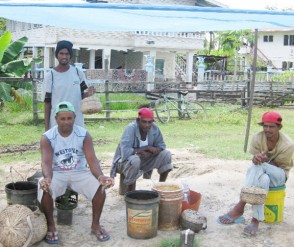
Kemp Khan who owns six boats said it cost a lot to go out in the deep sea and they were only paid a small price for the fish. He said the middlemen would purchase the fish from them and resell them to the local and export market.
He is even doing a business on the side to take tourists out on ‘special’ trips to fish for a few hours. “But ah don’t get that every day,” he said.
Over 30 persons are engaged in the fishing business which provides employment for about 60 residents.
Some of the other residents are employed in various sections at the Blairmont Estate. During the out-of-crop season, the cane-harvesters would “pull seine in the shallow water for shrimp” for an extra income.
Mud house
Gafiloon Esman, 72 who operates a shop close to the bridge said she has been living at D’ Edward since 1955 and always liked it there.
At the time the village was “bushy” with just a few houses and was called after an Englishman who was a manager at the Blairmont Estate. There was no street in the village and the few houses were located close to the brick road. Water from the sea sometimes flowed across the road during the high tide. The area was later surveyed and the first street was built of mud and more persons moved there to live.
Gafiloon said her husband, Mohamed Esman, 75, was a rice and cash crop farmer and she worked with him in the backdam after she got married at the age of 17.
During the crop time she would take her four “small children” and stay at a camp in the backdam. “We really punished to build life,” she said; “rice work was hard in those days.”
She recalled that they walked for miles to get to the rice field and after the cows “mashed down” the rice they would reap it with grass-knives.
After the crop she and other persons trekked through bushy areas then walked a “good way out to the river spot” with their seines to catch shrimp to sell.
The rice was sold to the Guyana Rice Board in Georgetown and was transported by train. Sometimes they paid to mill the rice and sold it for $16 per bag.
She lived with her family in four mud houses – building new ones after one was destroyed – which were daubed with “cow dung” to temporarily preserve them.
She loved to “tell the young people when they complain that life is hard, that none of them know what punishment is.”
After they stopped farming 20 years ago her husband bought a car and started operating a taxi. He also worked at Blairmont Estate as a cane-cutter and then as a tractor operator.
For five days her husband was paid $9.45 and if he worked on Sundays he would earn $2 extra.
During that time, Gafiloon did trading in Trinidad and would “walk and sell” grocery items for three years until she established the shop.
‘Aunty Gafi’ as she is fondly known, stopped the interview several times to tend to customers, most of who were from two private schools in the village. She said her shop is always busy since she started to sell cell phone cards.
She told this newspaper that the bridge had not impacted on her business as much as expected.
Kettin
Daveanand Persaud, a sign artist/electrician told this newspaper that the village had a stretch of land that was referred to as Kettin, and was thought to be government reserve.
He said that in the ’60s when persons from Mahaicony and other villages were displaced they squatted on portions of the land. “It so happened at that in 1976 when the slogan, ‘Feed, Clothe and House’ the nation came out, the local authority regularized the area and gave persons permission to stay on the land,” he said.
In 1990 officials from the Mahaica-Mahaicony-Abary scheme visited the area and informed them that the land belonged to the Guyana Congregational Union. They thereafter purchased the land and obtained transports for it. The area is still known as D’Edward Kettin.
Residents said the village became “populated in a jiffy” with several other businesses being established including, the Circuit City Internet café, auto sales, Chinese restaurant, three insurance companies, photo studio, welding shop, Bill Direct and a travel agency.
Social problems
One resident informed this newspaper that youths from one section of the village, known as ‘Crazytown’ were engaged in drug and alcohol abuse and gambling. He was not sure what could be done to stop them but knew that they “cannot carry on like that.” According to him, “most of the persons are cane-cutters and drinking is their hobby.”
He described how the weekend before the last, while some of the youths were gambling a fight broke out between them. One went away and returned with his friends to “beat up the others and even threw the wife of one of the victims in the trench.”
The matter ended up in the courts, but at the time the police were unable to find the person who started the fight, the resident said. He said there was also a problem with school dropouts and unemployment.
The man also expressed the view that some parents did not have control over their children and were to be blamed for most of their negative activities as they got older.
He felt that government should offer programmes to sensitize parents about bringing up their children in the right way.
Sports club
Derick Lalsa, owner of Lalsa’s General Store told this newspaper that many of the other youths were engaged in positive activities at the D’Edward Sports Club and were kept “out of trouble.”
Lalsa is the chairman of the club and manager of the cricket team, made up of under15, 17 and 19 and 2nd Division (senior) players. The senior team recently returned from Suriname after competing in the national team in that country and emerging victorious. He said they went there for a “return match” after first beating them at the Providence Stadium.
He said proudly that his son, Derick Jr had won the “player of the tournament” trophy and had also top scored with 181 runs for a school match.
Lalsa thanked Ministers Frank Anthony, Priya Manickchand and Robert Persaud, as well as King’s Jewellery World, Buddy Shivraj, Fazal Mahmood and Dr Kester Sullivan for making the trip possible.
He said the club was waiting on the Berbice Cricket Board to elevate them to 1st Division status and wanted to know the reason for the delay. He related that they had been winning all the tournaments since 1996.
He said some of the youths who were not involved in the club would jump the fence and destroy the pavilion and parents would “just leave them to do what they want.”
The club has a swing and is looking for sponsorship for a “see-saw.”
It also assists five youths to attend school; they had dropped out because of poverty.
He said, “When the management took over the club in 1994, the ground was like a pasture.” They subsequently acquired the funds to purchase 40 truckloads of reef sand and with the help of the Blairmont Estate they were able to level and roll the ground.
The President’s Youth Choice Initiative provided the club with a ‘bleacher’ and they approached the Social Impact Amelioration Programme (SIMAP) to assist with a multi-purpose centre, which was approved.
But first the club had to raise $842,000, most of which Lalsa contributed. Derick Jr also contributed all the equipment for the club’s gym.
Food for the Poor also provided four sewing machines. Lalsa mentioned too that a resident, Frankie Tulsi, donated a tennis table and equipment to the centre and Billy’s Electronic supplied a television and VCR.
The club also “worked its way up” to purchase a large refrigerator to sell beverages. He expressed gratitude to Banks DIH (Premium Beer) for adopting the club and ‘Donald’ of Canada for providing the members with uniforms.









